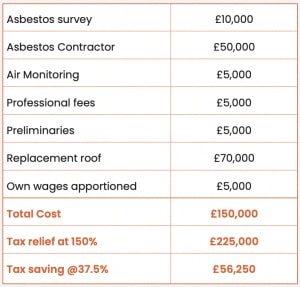What is Land Remediation Tax Relief?
If your property is owned or leased by a limited company, you (whether landlord or tenant) may be able to get tax relief on the costs of removing the asbestos and the replacement roof.
This is called land remediation tax relief, and it’s a government incentive to encourage companies to invest in the removal of asbestos.
With the current Corporation Tax rate of 25%, the tax cut can result in up to a 37.5% tax saving of the amount spent, e.g. a £100,000 spend could save £37,500.
Does my project fulfil the requirements for this tax relief?
The following conditions must be met to qualify for this government approved Tax Relief:
- The land/building must be in the UK.
- The company must purchase the property (or a minimum 7-year lease of it) for its commerce or real estate rental business.
- At the time of acquisition, the asbestos was present.
- The price of the property wasn’t reduced directly to allow the buyer to carry out the asbestos removal works.
What are the benefits of land remediation relief?
How much you can claim depends on the type of expenditure. Below are examples of how much your claim is worth depending on the spend.
Capital Spend
This is where the cost is capitalised and hasn’t gone through the profit and loss account. Companies can receive up to 150% relief under capital spend, resulting in a 37.5% tax savings gain (37.5p for every £1 spent).
Revenue Spend
This is where the cost has been put through the profit and loss account, and therefore already benefited from a reduction in corporation tax. These companies can receive up to an extra 50% relief, resulting in an additional tax savings gain of 12.5% (12.5p for every £1 spent).
This relief is also eligible for any projects that have been completed within the last 2 years.
Loss-making companies can claim a tax credit (cash in hand) of up to 24%.
Case Study
A TS Partners client wanted to cover a sheet roof with solar panels to reduce energy consumption, become more sustainable and reduce expenses. However, the roof sheets were made of asbestos, meaning the company couldn’t install solar panels directly onto the roof.
The company considered overlaying the asbestos with steel, but in the end, opted for removing the asbestos and replacing it with a new corrugated steel roof as the asbestos was nearing the end of its shelf life of 70 years.
Removing the asbestos qualifies for this tax relief, so on top of reducing energy costs and becoming more sustainable, our client made the following tax savings.

Download our information sheet: Asbestos_Removal_Tax_Relief_Info_Sheet
